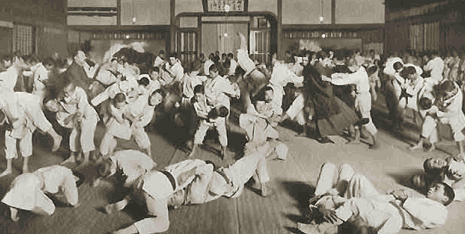by Dr. Stanislaw Sterkowicz
Head of Department of Combat Sports at Academy of Physical Education in Krakow, PolandIntroductionWhile training judo close contact between competitors is obvious. They use different techniques of throws, holds, levers and suffocations. Every fight begins in upright position and throws which cause falls lead to win. So children and youth must learn the techniques of soft falls or turnovers what is developed during continuous training. Youth usually use techniques of bending forward or to the right in Kuzushi (Sterkowicz 1987). Techniques of holds, levers and suffocations specific for judo are rarely used. A surprise attack on the opponent may cause injuries of the attacked competitors body. Most of the injuries take place during throws and falls (Fibak 1973, Forrisier 1975, Hapek 1966). Up to now dependencies among age, intensity and kind of injuries have not been explained yet. This paper deals with analysis of circumstances and reasons of body injuries according to age. MethodsRetrospective researches comprised 66% of people training judo in 22 chosen cities in Poland. There were 6468 subjects of varied age. On the basis of the data obtained from the Polish National Insurance (PZU) in four years (1977-1980) about 547 accidents and 563 injuries took place.. These people could not continue work or learning for about 1 till 2 months. within the group of children and youth 10-17 years old (group M) 306 accidents took place, within the group of grown-ups (group D) 241. For showing intensity of accidents the method of data junction was used; the same as in epidemiology (MacMahon 1974). The factor of accident frequency (A.F.) programmed by Reginato (1980) was used. It shows the amount of injuries for 100 training persons in half of period of time. The danger index A.F. was counted for the groups of ages and in general. To verify connection between age and characteristic features of people and accidents, special coefficient C- by Pearson was counted. Results and DiscussionOn the base of researches it can be stated that there is a dependence between intensity of accidents and age of people. The general danger index A.F. for four years was 8.5% (after counting it for 1 year it was similar to data from French Mutuelle Nationale des Sports (Chevaleraud 1978). During researches within the group of youth (M) there were 5.7% accidents. within the group D – 22.5. Risk in group M was 4 times less than in group D. Within the group D injured competitors represented higher level of judo knowledge than in group M. The number of accidents concerning the same competitors was 3 times higher in group D than in M. Among 213 injuries of upper limbs the most frequent were broken bones and put out joints. Among 134 injuries of legs, putting out joints dominated. Within head injuries auricles were mainly bruised. Overstrained stages were situated mainly in lumbar-sacral part of spine. Forrisier (1975) during researching in France in general obtained similar results. Percentage of upper limbs and of scapular arch injuries was the highest within the groups 10-13 and 14-15 years of age. It decreased in groups of older competitors. Quite the opposite situation was in injuries concerning legs, head and trunk. Comparing location of injuries among 18 disciplines of sport (Fibak 1973) it can be stated that injuries of scapular arch characteristic for judo were twice as frequent and injuries in head were 4 times less frequent; comparing to karate even 8 times (11). Above a half of injuries were broken bones and put out joints (Marker 1968). Broken bones were more frequent in young competitors’ groups, put out joint in grown-ups. Typical injuries like broken clavicle and broken forearms showed negative connections with age. Positive correlation was between age and putting out of joints of knees or elbow and clavicle-shoulder joint sprain. There is also a correlation between age and kind of mechanical injury or cause. Direct blow during throws dominated within 10-13, 14-15 and 18-19 years of age categories, pressing down or fall on an opponent in 16-17 and above 20 years of age categories. Wrong lean caused injuries in the 16-17 and 18-19 years of age groups. within the grown-up category most of injuries were caused be excessive friction and sudden resistance of opponent. Injuries caused by using levers, for the first time were noticed at 15 years old judoists who took part in competition. Described dependencies were statistically verified. the closest connection between age and kind of injuries and repeatability concerning the same persons was easy to be noticed. Injuries and their location also depend upon age (table 1). | 
